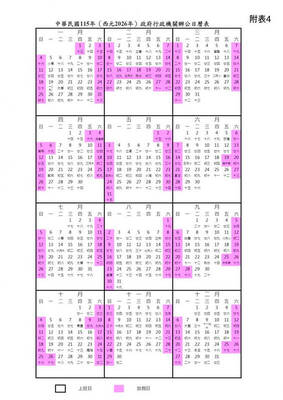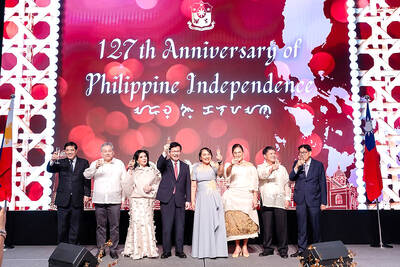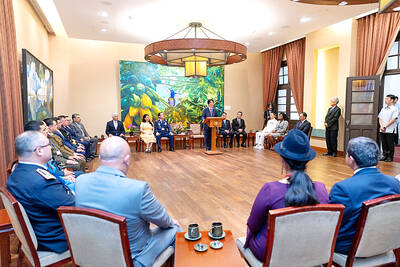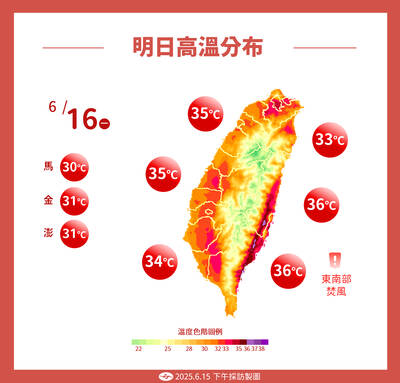Students from Tainan National University of the Arts (TNNUA) and the people of a small village in Houbi Township (後壁), Tainan County, have succeeded in transforming their community into one that combines traditional lifestyles and art.
Tugou (土溝) is one of 21 villages in Houbi. Although its size accounts for 10 percent of the township by size, the village has only 460 households and 1,700 people.
Nearly all of the village’s land is given over to farming and the residents are conservative and live a slow-paced life. Like most farming villages in Taiwan, it suffers from a drain of youth who move away for school or work, leaving only the elderly at home.
However, the situation changed in 2000 when Chang Chia-hui (張佳惠) was elected village chief and began trying to improve the lives of residents by improving the environment.
He formed a community empowerment society with some of the more active villagers, planting flowers and turning unused land into a public square where people could sit and chat while their grandchildren play.
“People will support community empowerment once they begin to enjoy the benefits of it,” he said.
Community empowerment is about people and government working together to bring about improvements.
It allows more people the chance to influence decisions about their communities and take responsibility for tackling local problems, rather than expecting others to do it for them.
The idea is that neither the government nor the community can solve everything itself, so it’s better for them work together.
Chang’s efforts came to the attention of Tseng Shu-cheng (曾旭正), a professor at TNNUA, who used to serve as deputy commissioner of Tainan County.
Tseng believed that his students at the university’s Graduate Institute of Architecture could help the villagers and told them they could apply the skills they learned in the classroom to Tugou and write about their experiences.
Shortly after that, the first group of students moved into Tugou.
“This is more than just study or homework. To find out what most suits the needs of the villagers, you have to be a part of them and think like them,” Tseng told the students.
The first project undertaken by the students, mostly in their 20s, and the residents, many in their 80s, was converting a disused pig pen owned by Chang into a public living room decorated with artwork.
The second collaboration involved the renovation of a public space in an even smaller settlement called Chuzihciao, which at the time had only 29 households.
The students asked painter Yin Chia-hui (殷嘉輝) to paint the outer walls of the houses and sculptor Ho Chia-fu (侯加福) to carve stone snails for the space — a symbol of peace.
Bao A-mo, an elderly woman living in the settlement, said that since the renovation the square has attracted residents, who gather there to chew the fat.
“It is a more pleasant place now, and has strengthened the association between neighbors,” she said.
The students who live in the settlement also became accustomed to village life and have effectively become residents themselves.
“The local people are upfront with their feelings. If they don’t like my ideas they will reject them outright, “ said Yang Han-ya, one of the students. “I got so frustrated that I often burst into tears during discussions at the beginning. I couldn’t understand why they insisted on their own feelings and didn’t trust my expertise.”
However, after living among them for more than a year, Yang now counts herself as one of the villagers. Local residents shout out greetings to her when she rides her scooter through Chuzihciao and stop her for a chat when she walks around Tugou.
Lu Yao-chung was one of the first group of students to move into Tugou. He graduated from the Graduate Institute of Architecture after living there for two years, only to return to the village to open his own design firm after finishing his military service.
He was glad to see the program had entered its sixth year.
Lu said Tugou is a beautiful place that inspires him to turn out work that is different from his competitors.
“Of course, the cheap cost of opening a firm here is another reason why I chose it over a big city to set up my studio,” he said.
Lu is not alone. Ho, the sculptor, built a studio in Chuziciao that was designed by students, and has become the 30th household there.
“Before, when asked ‘Where do you live,’ local people used to reply with ‘near Sinying (新營),’ or ‘next to Baihe Township (白河),’ because few outsiders would know where Tugou is, but now they simply say ‘Tugou,’” Chang said with pride.

Taiwan is to have nine extended holidays next year, led by a nine-day Lunar New Year break, the Cabinet announced yesterday. The nine-day Lunar New Year holiday next year matches the length of this year’s holiday, which featured six extended holidays. The increase in extended holidays is due to the Act on the Implementation of Commemorative and Festival Holidays (紀念日及節日實施條例), which was passed early last month with support from the opposition Chinese Nationalist Party (KMT) and Taiwan People’s Party. Under the new act, the day before Lunar New Year’s Eve is also a national holiday, and Labor Day would no longer be limited

Taiwan is to extend its visa-waiver program for Philippine passport holders for another year, starting on Aug. 1, Minister of Foreign Affairs Lin Chia-lung (林佳龍) said on Friday. Lin made the announcement during a reception in Taipei marking the 127th anniversary of Philippine independence and the 50th anniversary of the establishment of the Manila Economic and Cultural Office (MECO) in Taiwan, the Ministry of Foreign Affairs said. The decision reflected Taiwan’s commitment to deepening exchanges with the Philippines, the statement cited Lin as saying, adding that it was a key partner under the New Southbound Policy launched in 2016. Lin also expressed hope

Costa Rica sent a group of intelligence officials to Taiwan for a short-term training program, the first time the Central American country has done so since the countries ended official diplomatic relations in 2007, a Costa Rican media outlet reported last week. Five officials from the Costa Rican Directorate of Intelligence and Security last month spent 23 days in Taipei undergoing a series of training sessions focused on national security, La Nacion reported on Friday, quoting unnamed sources. The Costa Rican government has not confirmed the report. The Chinese embassy in Costa Rica protested the news, saying in a statement issued the same

Temperatures in New Taipei City’s Sindian District (新店) climbed past 37°C yesterday, as the Central Weather Administration (CWA) issued heat alerts for 16 municipalities, warning the public of intense heat expected across Taiwan. The hottest location in Taiwan was in Sindian, where the mercury reached 37.5°C at about 2pm, according to CWA data. Taipei’s Shilin District (士林) recorded a temperature of 37.4°C at noon, Taitung County’s Jinfeng Township (金峰) at 12:50 pm logged a temperature of 37.4°C and Miaoli County’s Toufen Township (頭份) reached 36.7°C at 11:40am, the CWA said. The weather agency yesterday issued a yellow level information notice for Taipei, New